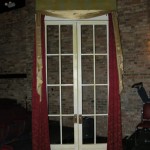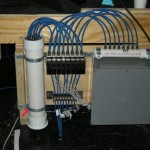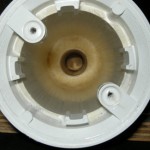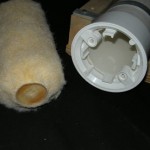House Theatre of Chicago’s original-script production of The Nutcracker demanded moving, changing scenery that magically transformed the set at the push of a button. AutomationDirect’s extensive line of pneumatic and electrical components helped us realize these design elements easily, elegantly, and reliably. 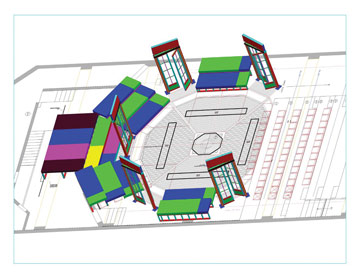
The Doors:
The set design consisted of five sets of custom built French door units which were completely freestanding. These door units provided the “theatre-in-the-round” entrances for the actors. At the climax of the show, when young Clara’s world is about to fall apart, scenic designer Collette Pollard envisioned the world physically cracking and beginning to come apart.
Using AutomationDirect’s single-acting pneumatic cylinders, the “door toppers,” situated above the doors, pivoted from one side, pushed up by the cylinder.
The cylinders were embedded in the vertical doorframe posts. The frames were constructed of 2″ square steel box tube to provide a hollow space for the cylinders, and then cased in wood to provide the proper dimensions and appearance.
To prevent binding, the cylinder was topped with a plastic ball which allowed the end to slide as the cylinder extended. The air line ran down the frame and out to the control panel upstage.
The Tree:
The closing scene of Nutcracker called for a small Christmas tree to magically grow from the stage on command. The design team wanted a tree that grew from nothing to approximately 18 inches.  The tree planter, filled with fake snow, had a false bottom which the tree punched through to magically appear when desired. Our “Charlie Brown Tree” was built from various diameters of polyethylene tubing wrapped with soft iron wire and covered with painted heatshrink tubing. The hinges at the base of the branches were simply short lengths of extension spring which allowed the tree to collapse into a piece of 1.5″ PVC pipe.
The tree planter, filled with fake snow, had a false bottom which the tree punched through to magically appear when desired. Our “Charlie Brown Tree” was built from various diameters of polyethylene tubing wrapped with soft iron wire and covered with painted heatshrink tubing. The hinges at the base of the branches were simply short lengths of extension spring which allowed the tree to collapse into a piece of 1.5″ PVC pipe.
The tree was pushed up through the floor by a 1″ bore, 18″ stroke double-acting cylinder. The double-acting feature allowed the stage crew to easily retract and reset the tree between performances.
The cylinder was able to push the tree around the 90-degree bend because the tree’s “trunk” was also made of poly tubing; flexible yet rigid enough to withstand pushing by the cylinder.
There are three air lines attached to the under-stage tree mechanism; one each to extend and retract, as well as a purge line that was used to blow the fake snow out of the tree storage tube before retraction. The purge line was added after we found that the fake plastic snow which fell into the tube prevented the tree from moving smoothly. It is important to note that the tree itself remained vertical and never “turned the corner.” The horizontal portion contained only the travel of the cylinder and the poly tubing “pushrod.”
The Control Panel:
The AutomationDirect three-way pneumatic valves were operated by an eight-way MIDI-to-relay card through single-pole interposing relays. MIDI control was chosen as it is a control protocol native to the audio world; since the effects had to fire in time with sound effects, it made sense to allow the audio playback computer to control the actuation of the valves.
It might be noticed that even though we have a double-acting cylinder for the tree, all eight valves are 3-way, and not necessarily suited to controlling a double-acting cylinder. We simply used two 3-way valves, one for each side of the cylinder, to minimize air loss around the seals of the cylinders. Because we could not run our compressor during the show due to noise, our air supply was limited. Use of the single-acting cylinders was limited to a rather short time, and the tree’s cylinder did not need air once it was extended or retracted. The purge line used to blow the fake snow out from around the tree was only used post-show, and thus we were able to run the compressor as needed for additional air.
A large white cylinder was mounted to the left of the panel to serve as a muffler; it silenced the sound of venting air as the cylinders were extended and retracted. It was built from 3″ diameter PVC pipe and fuzzy paint rollers with their center tubes glued closed. This forced the air through the nap of the rollers and out through a grate on the bottom of the pipe.
Our use of AutomationDirect’s extensive line of pneumatic and electric supplies and parts allowed House Theatre to tell the tale of The Nutcracker in ways that truly brought the audience into the story. Without support from AutomationDirect, House Theatre would not have been able to add this dimension of scenery movement and magic to our storytelling.
By Ryan Poethke
Originally Posted: June 1, 2011


